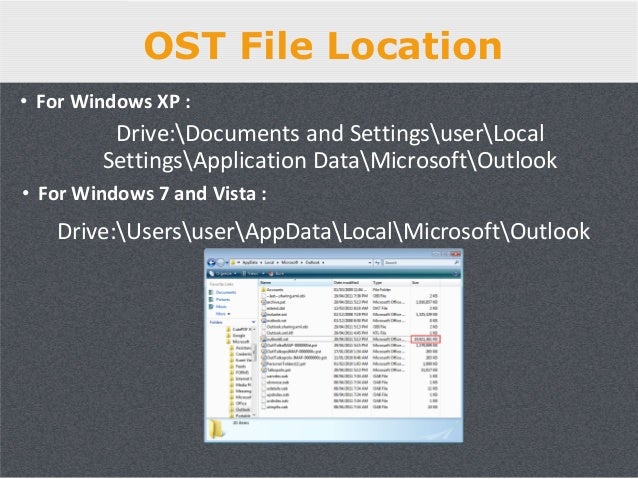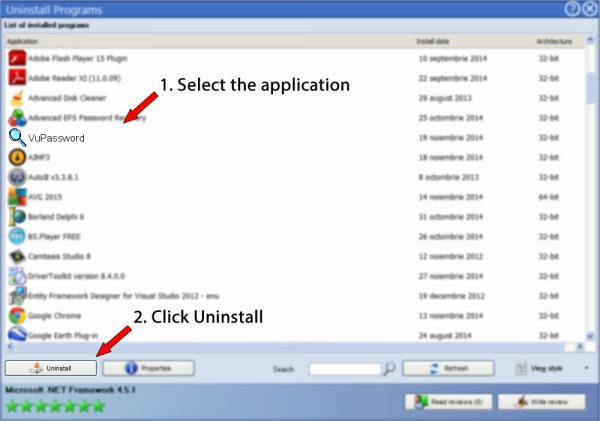


- #WINDOWS 7 OUTLOOK OST FILE LOCATION HOW TO#
- #WINDOWS 7 OUTLOOK OST FILE LOCATION MANUAL#
- #WINDOWS 7 OUTLOOK OST FILE LOCATION SOFTWARE#
- #WINDOWS 7 OUTLOOK OST FILE LOCATION OFFLINE#
#WINDOWS 7 OUTLOOK OST FILE LOCATION HOW TO#
How to View Hidden Files and Folders For Windows Vista: Some of these files might be hidden, so you may need to turn on the option to show hidden files and folders before you can locate the files. Note that you probably will not find all of the files listed below in your configuration, because some of the files are not created until you customize Outlook features. This article lists all the possible Outlook files that you may want to include in your backups. You may also want to manually back up or export other Outlook files. pst files, which store everything for Outlook. Microsoft provides an Outlook add-in called Personal Folders Backup. It is compatible with Microsoft Outlook 2019, 2016, 2013, 2010, 2007, and lower versions.It is important to back up email files on a regular basis.
#WINDOWS 7 OUTLOOK OST FILE LOCATION SOFTWARE#
The software can easily convert orphaned or inaccessible OST to PST file, which you can import OST into Outlook and access all its mail items.Ībove all, the OST to PST software can be used if the OST file is damaged or corrupt. The best way to convert an OST to PST is by using an advanced tool such as Stellar Converter for OST. Such OST file needs to be converted to PST to access its data. You can’t access an orphaned OST with your Outlook. In such a case, the OST file may become inaccessible or orphaned.

You may face issues after changing Outlook data file location or the process may go wrong due to some error. Video can’t be loaded because JavaScript is disabled: Stellar Converter for OST – Best OST to PST Converter Software, Convert OST to PST now () ConclusionĬhanging default location of OST file is not always recommended. Mklink %localappdata%\Microsoft\Outlook\ "D:\Outlook Data Files\"
#WINDOWS 7 OUTLOOK OST FILE LOCATION OFFLINE#
Here, select the Browse tab, then the offline Outlook Data (OST) file that was moved to a new folder at any location, and then click Open.

Note: If the Disable Offline Use option is unavailable, return to Step 3 and uncheck the Use Cached Exchange Mode checkbox. In the Advanced tab, choose Outlook Data File Settings > Disable Offline Use > Yes.The steps to change OST file location are as follows:įigure 5: Actions in the Advanced section of Microsoft Exchange account Note: All Outlook versions use a different location to store the OST files. By using the Registry Key, you can change the OST file location on all Outlook versions, be it Outlook 2019, 2016, 2013, 2010, 2007, or 2003. You can use ForcePSTPath, which is a Windows Registry Key, to change the Outlook data file location. Method 1: Set ForcePSTPath Registry Entry
#WINDOWS 7 OUTLOOK OST FILE LOCATION MANUAL#
How to Change Outlook Data File Location?įollowing are some manual methods that you can use to change OST file location in Outlook 2019, 2016, 2013, and 2010 on Windows 10. If, for any reason, you want to change Outlook data file location in Windows 10, read this post to know the methods and workarounds for changing the OST file location. If that’s not possible, you can use Stellar Converter for OST to convert OST to PST on same system, and then open the PST in Outlook on new system in few simple steps. You can, however, recreate the OST on the new machine. Note: You can’t change Outlook data file location from one machine to another to access its contents. However, at times, you need to change the default Outlook file location due to various reasons, such as lack of storage space where the file is saved, an Outlook account is deleted, or any other. It is usually not required to change OST file location. The OST file is saved at a default location on local storage. and allows users to work offline in the Exchange environment. The OST file stores data, such as email messages, tasks, contacts, calendar, etc. Offline Storage Table or OST is an Outlook data file that is created locally when you set up Microsoft Outlook account.


 0 kommentar(er)
0 kommentar(er)
